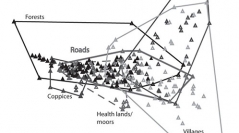

 Cryptogamie, Algologie
36 (3) - Pages 305-322
Cryptogamie, Algologie
36 (3) - Pages 305-322Diatoms coming from 140 ponds (“mares”) from two regions of France the Calcareous plateau of the Beauce in the north and the sand and clay region of Orléans and Sologne in the south were analyzed for the influence of regional geology, land use and growth support. Both permanent ponds and ephemeral ponds were included in the analyses. Multiresponse permutation procedure illustrated the differences and similarities between the two regions, the 13 different classes of pond type and different substrates. The analyses demonstrated why certain types should be regrouped into one large class, with six pond types retained. Most of the substrates categories showed no significant differences but one category, Sphagnum (peat moss) was different from all the others while mud and living roots also differed from many of the other categories.
Canonical correspondence analyses of both regions together and then each region separately using only the permanent pond data resulted in different environmental factors explaining species ordination. For the two regions combined three essential factors were determined; pH, log conductivity, and pond surface area. The Beauce calcareous plateau was influenced by pH and K while the sand and clay region of Orléans and Sologne were influenced by log conductivity, and SiO2 on axis 1-2.